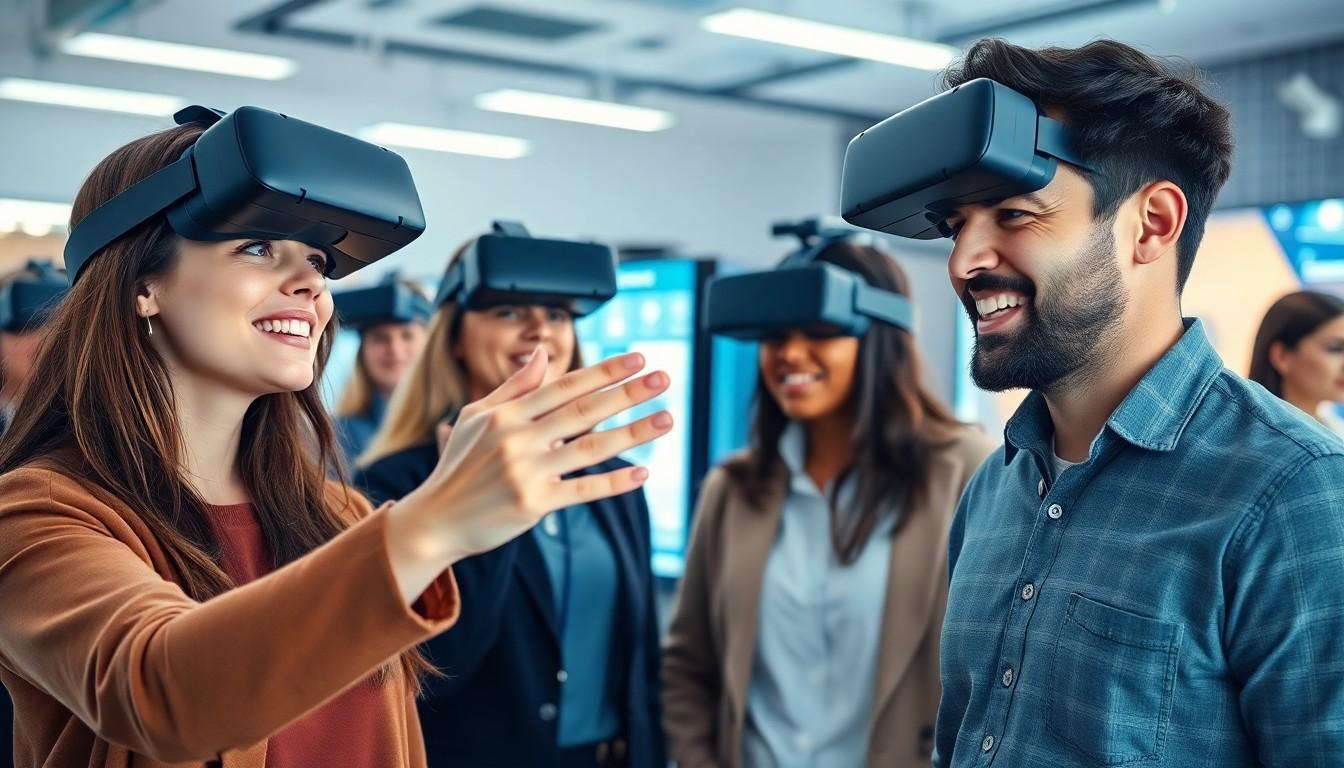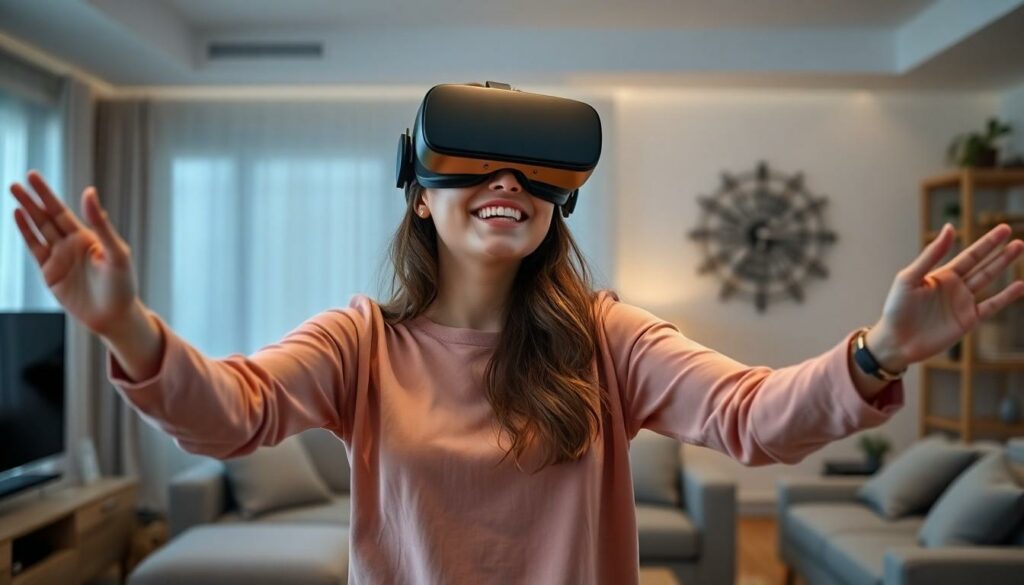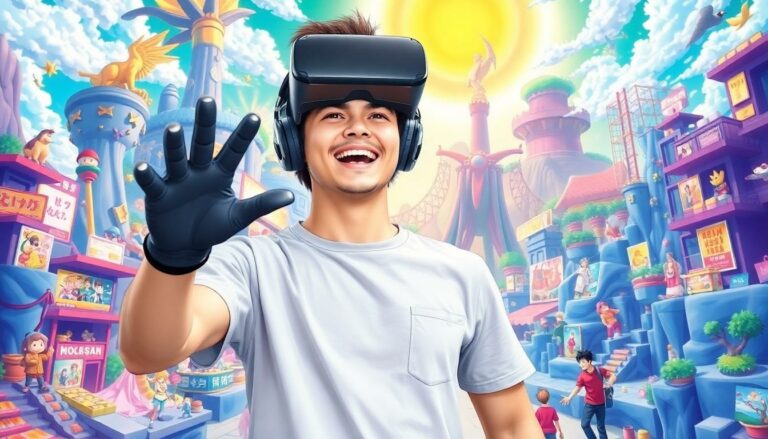Table of Contents
ToggleImagine slipping on a headset and instantly being transported to a world where your only limits are your imagination. Welcome to the realm of virtual reality services, where the mundane transforms into the extraordinary. Whether it’s exploring distant galaxies or diving deep into the ocean, VR opens doors to experiences that were once confined to the pages of sci-fi novels.
Overview of Virtual Reality Services
Virtual reality services encompass a range of technologies designed to create immersive experiences. These services allow users to interact with 3D environments, enhancing various industries such as gaming, education, and healthcare. VR offers simulations that can replicate real-world scenarios, enabling effective training and skill development.
The gaming industry benefits significantly from VR, providing intense, engaging experiences. Popular titles immerse players in intricate worlds where interaction leads to seconds that feel like hours. Specialized platforms focus on multiplayer modes, allowing players to connect globally.
Education also embraces these services, using VR to conduct virtual field trips and historical recreations. Students explore ancient civilizations or conduct science experiments in a controlled setting. Immersive lessons foster deeper understanding and retention of information.
Healthcare implements virtual reality for patient treatment and training. Medical professionals simulate surgeries or patient interactions within safe environments. This approach offers practical experience without the risks associated with real-life practice.
Furthermore, businesses utilize VR for marketing and customer engagement. Virtual showrooms allow potential buyers to experience products before purchase. Engaging advertisements capture attention in ways traditional media cannot.
Investment in VR technology is increasing, with rapid advancements enhancing capabilities and accessibility. Companies now focus on developing software and hardware that can deliver lifelike visuals and responsive interactions. Collaboration between tech developers and industry leaders promotes innovative applications of VR services.
This growing landscape presents opportunities for various sectors to adopt VR, transforming how people learn, work, and play.
Benefits of Virtual Reality Services

Virtual reality services offer multiple advantages that enhance various experiences.
Enhanced User Experience
Immersive environments capture attention and create memorable interactions. Users encounter realistic simulations that engage their senses, resulting in deeper connections with content. Training environments in corporate sectors showcase how VR prepares employees by simulating real-world scenarios. Education particularly benefits from VR, enabling students to visualize complex concepts in engaging ways. Historical events come alive through interactive experiences, making learning enjoyable. Users find that VR empowers them to explore new environments like art galleries or historical sites without leaving home. This transformative approach to experience reshapes how individuals interact with information.
Increased Engagement
Engagement levels soar with virtual reality services. Businesses note significant improvements in customer interaction, as users immerse themselves in brand experiences. Virtual showrooms captivate potential buyers, allowing them to examine products without physical constraints. Alongside this, entertainment industries leverage VR to create unforgettable gaming experiences, pulling players into expansive worlds. Content creators utilize VR to produce stories that invite audiences to participate actively. Educational institutions find that students absorb information better when immersed in interactive learning modules. By transforming passive activities into engaging experiences, VR significantly heightens user involvement.
Applications of Virtual Reality Services
Virtual reality services have wide-ranging applications across multiple sectors, showcasing their versatility and impact.
Entertainment and Gaming
Gaming has undergone a revolution due to VR services. Immersive experiences transport players into interactive worlds where they can feel a part of the story. Engaging graphics and haptic technology enhance realism. Titles like “Beat Saber” and “Half-Life: Alyx” illustrate how VR can transform traditional gaming into captivating adventures. Players can explore environments and interact with objects in ways that enhance their overall experience. The industry’s growth reflects the demand for more innovative and immersive entertainment options.
Education and Training
In educational settings, virtual reality enhances learning experiences significantly. Students benefit from virtual field trips that transport them to historical landmarks or biologically diverse ecosystems. Interactive lessons allow for deeper understanding of complex subjects, such as anatomy, through simulations. Institutions utilize VR for corporate training as well, providing real-world scenario practice in a safe environment. This hands-on approach fosters effective skill development, preparing individuals for future challenges.
Healthcare and Therapy
Healthcare increasingly integrates VR technology for both treatment and training. Medical professionals can simulate surgeries for practice, improving their skills without risk to patients. Patients undergoing therapy benefit from VR exposure techniques, helping them confront phobias or manage pain through distraction. The adaptability of VR in therapeutic settings showcases its potential to improve patient outcomes. With ongoing research, the impact of VR on healthcare will continue to grow, offering innovative solutions to enhance medical practices.
Challenges in Virtual Reality Services
Virtual reality services face several challenges that impact their effectiveness and accessibility. These obstacles can hinder the growth of VR across various industries.
Technical Limitations
Technical limitations profoundly affect the immersion of virtual reality. High-performance hardware requirements may restrict user access, as not everyone owns advanced VR systems. Latency issues in VR experiences lead to discomfort or motion sickness, disrupting engagement. Furthermore, content creation often involves significant time and resource investments, deterring smaller developers from entering the market. Even emerging technologies struggle with scalability due to varying levels of performance on different devices. User experiences can suffer when applications lack optimization, highlighting the necessity for developers to address these challenges.
User Accessibility
User accessibility remains a crucial barrier for widespread VR adoption. Many potential users encounter difficulties due to the high cost of VR equipment, which includes headsets and compatible hardware. Physical limitations also pose challenges, as individuals with mobility impairments may find it hard to navigate virtual environments. Additionally, inadequate onboarding processes can leave new users overwhelmed by complex interfaces. Software compatibility across devices can further complicate access, alienating users who are not tech-savvy. Simplifying interactions and lowering financial barriers can significantly enhance accessibility, allowing more individuals to experience the benefits of virtual reality services.
Future Trends in Virtual Reality Services
Emerging technologies continue to shape the future of virtual reality (VR) services. Enhanced hardware, like lightweight headsets and improved graphics, will provide users with even more immersive experiences. These advancements make onboard interactions smoother and reduce physical discomfort during extended use.
In education, VR services are expected to evolve further. Schools and universities may adopt VR for personalized learning experiences, tailoring content to individual student needs. Interactive simulations can enhance understanding of complex subjects, fostering deeper engagement.
Healthcare also sees significant potential in VR. Expanded uses will include remote therapy sessions and stress relief practices. Patients may utilize VR to undergo rehabilitation in engaging virtual environments, which can positively influence recovery times.
Marketing strategies are shifting with VR’s capabilities as well. Brands could create hyper-realistic virtual experiences, allowing customers to engage with products before purchasing. Companies might develop tailored advertisements that adapt in real time based on user interaction.
Social interactions within virtual spaces are on the rise too. Virtual meet-ups and events can facilitate unbounded connections among individuals globally. Communities formed in these environments may compete with traditional social networks, offering enhanced engagement.
Investment in VR development continues to surge. Collaborations among tech leaders create opportunities for innovative applications across diverse sectors. This trend indicates a commitment to pushing the boundaries of what VR can achieve, promising captivating experiences.
Overall, VR services are set for exciting transformations. Optimistic projections suggest increased user adoption as technology advances. Businesses could witness substantial changes in customer engagement methods, elevating interactions to a new level.
The future of virtual reality services is bright and full of potential. As technology continues to advance, users will experience even more immersive and engaging environments. The applications across various sectors promise to reshape how individuals learn, work, and connect with one another.
With ongoing investment and collaboration among industry leaders, VR is set to break down barriers and enhance accessibility. By addressing challenges and simplifying user interactions, more people can enjoy the transformative benefits of virtual reality. As VR evolves, it’s clear that its impact on society will only grow, creating new opportunities for innovation and engagement.




